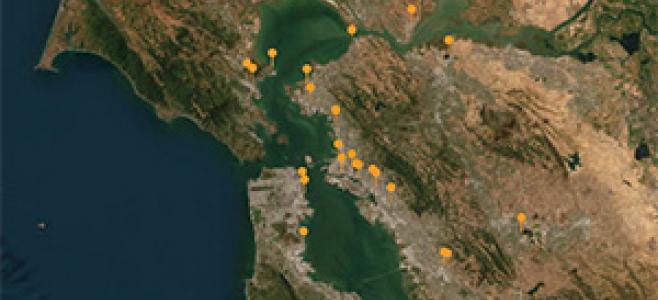Bay Area cities are taking steps toward keeping trash, toxic chemicals and pesticides from washing into San Francisco Bay during the rainy season. However, Baykeeper is concerned that cities are not making enough progress to meet some of their targets for reducing their storm water pollution.
Baykeeper helped secure region-wide municipal storm water controls, adopted in 2009, that require city governments around the Bay Area to manage and reduce storm water pollution—rain water that carries contaminants from yards, streets, roofs and parking lots and enters the Bay via creeks and storm drains, without being filtered or treated.
Under the new requirements, cities are now required to report to the State Water Board each year on their progress and plans for keeping polluted storm water out of the Bay. Baykeeper recently analyzed the second year of reports for four Bay Area counties—Alameda, Contra Costa, San Mateo and Santa Clara—plus the Solano County cities of Vallejo and Fairfield-Suisun. Here are some highlights:
Trash: Most cities have identified trash hot spots, but they are doing little or nothing to reduce trash washing into the Bay. At this rate, cities are unlikely to meet the established target of reducing their trash loads in the Bay by 40% in 2014 and 100% by 2022.
Mercury: Cities are working on pilot projects for keeping mercury-contaminated storm water out of the Bay, but most of these projects are a long way from being complete or effective. Many cities don’t have adequate programs for collecting and recycling mercury-containing consumer products (such as thermometers and CFL light bulbs). In addition, cities aren’t meeting requirements to monitor their storm water levels of methylmercury, a toxic form of mercury that accumulates in the ecosystem.
PCBs: PCBs are toxic chemicals used in electronics until they were banned in 1979. They do not break down in the environment and accumulate in the Bay food chain. PCBs are also present in many Bay Area buildings, making PCB runoff pollution a threat during building demolition. However, cities are not implementing required pilot projects to control PCB pollution.
Other toxic pollutants: Cities are not meeting requirements to test their storm water runoff for a number of other toxic pollutants, including the banned pesticide DDT and flame retardant chemicals.
Development: Cities are generally on target for reducing storm water pollution from new development and redevelopment. Projects are being designed with required low-impact development features that filter and remove pollutants from storm water on site. Some cities are also implementing pilot low-impact development projects, such as the San Pablo Avenue Green Stormwater Spine, 12 miles of urban runoff pollution prevention infrastructure along a major thoroughfare in several East Bay cities. However, there’s a need for better inspection of these storm water controls during the rainy season to find out how well they are actually reducing pollution.
Construction sites: Most Bay Area cities have robust construction site inspection and control programs to help prevent storm water contamination of the Bay. However, there is room for improvement in inspection and in enforcement when controls are inadequate.
Storm water runoff is the leading cause of water pollution in the Bay Area, and in virtually every urban area in the nation. Historically, cities have attempted to reduce this pollution through methods such as street cleaning or installing storm drain traps to collect trash. However, given the diffuse nature of pollutants found in storm water and the difficulties in regulating each individual source, many pollutants still reach local waterways.
Baykeeper invested many years of advocacy to help win better regulations for storm water runoff into the Bay. After we sued several Bay Area cities under the Clean Water Act for deficient storm water management, the San Francisco Bay Regional Water Board spent several years creating a single set of guidelines that apply to the four largest Bay Area counties, as well as the North Bay cities of Fairfield-Suisun and Vallejo. By working closely with the Regional Board to improve the guidelines, Baykeeper was able to secure stronger controls on trash, pesticides and other toxic pollution in storm water.
However, winning better regulations is only the beginning. It takes continuing monitoring and advocacy to get regulations enforced in a way that leads to pollution cleanup.
Over the coming year, Baykeeper will continue to advocate for more effective management of storm water pollution from Bay Area cities. It is crucial that cities meet every requirement of the new rules to translate our policy victories into cleaner and safer San Francisco Bay waters.


